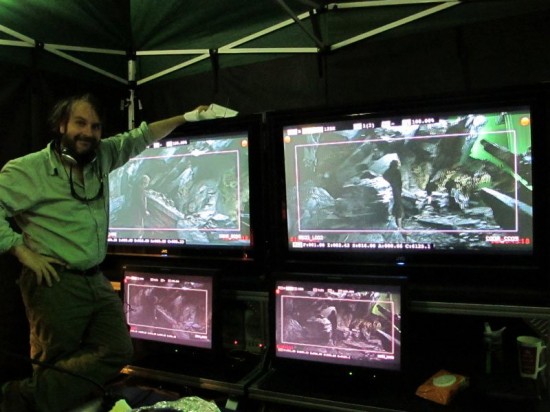
It’s difficult to share my excitement about a technology when no one has the chance to experience it quite yet. It was revealed earlier in the month that The Hobbit was shooting in 48 frames-per-second, but we weren’t sure what they planned to do with the footage, or if it even had the capacity to be projected in proper fashion. Today, director Peter Jackson gave a large update on the process and he does a far better job than I ever could about what this advancement means and if we will actually see it in theaters. Check it out below via his Facebook page.
We are indeed shooting at the higher frame rate. The key thing to understand is that this process requires both shooting and projecting at 48 fps, rather than the usual 24 fps (films have been shot at 24 frames per second since the late 1920′s). So the result looks like normal speed, but the image has hugely enhanced clarity and smoothness. Looking at 24 frames every second may seem ok–and we’ve all seen thousands of films like this over the last 90 years–but there is often quite a lot of blur in each frame, during fast movements, and if the camera is moving around quickly, the image can judder or “strobe.”
Shooting and projecting at 48 fps does a lot to get rid of these issues. It looks much more lifelike, and it is much easier to watch, especially in 3-D. We’ve been watching HOBBIT tests and dailies at 48 fps now for several months, and we often sit through two hours worth of footage without getting any eye strain from the 3-D. It looks great, and we’ve actually become used to it now, to the point that other film experiences look a little primitive. I saw a new movie in the cinema on Sunday and I kept getting distracted by the juddery panning and blurring. We’re getting spoilt!

Originally, 24 fps was chosen based on the technical requirements of the early sound era. I suspect it was the minimum speed required to get some audio fidelity out of the first optical sound tracks. They would have settled on the minimum speed because of the cost of the film stock. 35mm film is expensive, and the cost per foot (to buy the negative stock, develop it and print it), has been a fairly significant part of any film budget.
So we have lived with 24 fps for 9 decades–not because it’s the best film speed (it’s not by any stretch), but because it was the cheapest speed to achieve basic acceptable results back in 1927 or whenever it was adopted.
None of this thinking is new. Doug Trumbull developed and promoted a 60 frames per second process called ShowScan about 30 years ago and that looked great. Unfortunately it was never adopted past theme park use. I imagine the sheer expense of burning through expensive film stock at the higher speed (you are charged per foot of film, which is about 18 frames), and the projection difficulties in cinemas, made it tough to use for “normal” films, despite looking amazing. Actually, if anybody has been on the Star Tours ride at Disneyland, you’ve experienced the life like quality of 60 frames per second. Our new King Kong attraction at Universal Studios also uses 60 fps.

Now that the world’s cinemas are moving towards digital projection, and many films are being shot with digital cameras, increasing the frame rate becomes much easier. Most of the new digital projectors are capable of projecting at 48 fps, with only the digital servers needing some firmware upgrades. We tested both 48 fps and 60 fps. The difference between those speeds is almost impossible to detect, but the increase in quality over 24 fps is significant.
Film purists will criticize the lack of blur and strobing artifacts, but all of our crew–many of whom are film purists–are now converts. You get used to this new look very quickly and it becomes a much more lifelike and comfortable viewing experience. It’s similar to the moment when vinyl records were supplanted by digital CDs. There’s no doubt in my mind that we’re heading towards movies being shot and projected at higher frame rates.
Warner Bros. have been very supportive, and allowed us to start shooting THE HOBBIT at 48 fps, despite there never having been a wide release feature film filmed at this higher frame rate. We are hopeful that there will be enough theaters capable of projecting 48 fps by the time The Hobbit comes out where we can seriously explore that possibility with Warner Bros. However, while it’s predicted that there may be over 10,000 screens capable of projecting THE HOBBIT at 48 fps by our release date in Dec, 2012, we don’t yet know what the reality will be. It is a situation we will all be monitoring carefully. I see it as a way of future-proofing THE HOBBIT. Take it from me–if we do release in 48 fps, those are the cinemas you should watch the movie in. It will look terrific!
Are you as excited about the higher framerate as I am or do you need to see it in action first?

